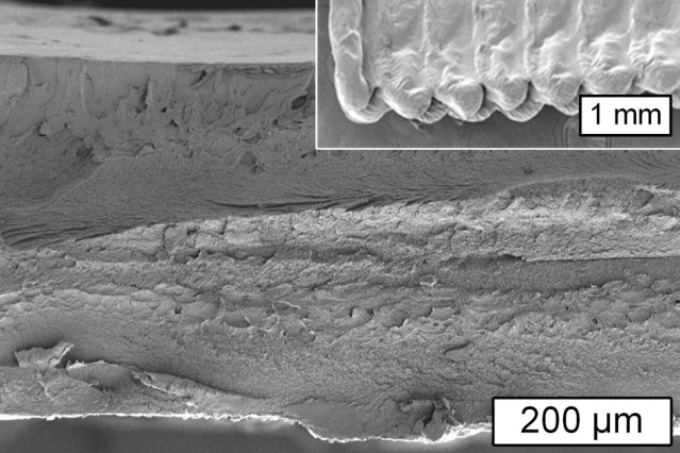Mar 6 2017
 This image from a scanning electron microscope shows a cross section of an object printed using cellulose. The inset shows the surface of the object. CREDIT: Courtesy of the researchers.
This image from a scanning electron microscope shows a cross section of an object printed using cellulose. The inset shows the surface of the object. CREDIT: Courtesy of the researchers.
For hundreds of years, the base material for forming the world’s most significantly printed-on material - paper - has been cellulose. A new study performed recently at MIT can render it also as an abundant material to print with, potentially providing b biodegradable and renewable substitute to the polymers that are used at present in three-dimensional (3D) printing materials.
Cellulose is the most abundant organic polymer in the world.
Sebastian Pattinson, Postdoc, MIT
Pattinson is the lead author of a paper outlining the details related to the new system in the Advanced Materials Technologies journal. A. John Hart, associate professor of mechanical engineering and the Mitsui Career Development Professor in Contemporary Technology, is the co-author of the paper.
[Cellulose is] the most important component in giving wood its mechanical properties. And because it’s so inexpensive, it’s biorenewable, biodegradable, and also very chemically versatile, it’s used in a lot of products. Cellulose and its derivatives are used in pharmaceuticals, medical devices, as food additives, building materials, clothing — all sorts of different areas. And a lot of these kinds of products would benefit from the kind of customization that additive manufacturing [3-D printing] enables.
Sebastian Pattinson, Postdoc, MIT
At the same time, there has been a rapid growth in the field of 3D printing technology. An advantage of the technology is that it “allows you to individually customize each product you make,” stated Pattinson.
Although the use of cellulose as a base material for additive manufacturing has been attempted by many scientists, there have been major challenges in this field. Upon heating, cellulose gets thermally decomposed before attaining a flowable state.
This is partially due to the hydrogen bonds between the cellulose molecules. Such intermolecular bonding also renders high-concentration cellulose solutions to be highly viscous to be extruded effortlessly.
As an alternative, the MIT researchers chose to use cellulose acetate, which can be easily produced from cellulose and is already widely produced and readily available. Fundamentally, the acetate groups reduce the hydrogen bonds in this material. After dissolving in acetone, cellulose acetate can be extruded through a nozzle.
The quickly evaporating nature of acetone helps the cellulose acetate to solidify in place. The acetate groups are replaced by a successive optional treatment, thus increasing the strength of the printed parts.
“After we 3-D print, we restore the hydrogen bonding network through a sodium hydroxide treatment,” explained Pattinson. “We find that the strength and toughness of the parts we get ... are greater than many commonly used materials” for 3D printing, such as polylactic acid (PLA) and acrylonitrile butadiene styrene (ABS).
Pattinson and Hart performed an additional step to exhibit the chemical versatility of the production technique. They added a small amount of antimicrobial dye to the cellulose acetate ink and 3D-printed a pair of surgical tweezers that had antimicrobial functionality.
We demonstrated that the parts kill bacteria when you shine fluorescent light on them. [Such custom-made tools] could be useful for remote medical settings where there’s a need for surgical tools but it’s difficult to deliver new tools as they break, or where there’s a need for customized tools. And with the antimicrobial properties, if the sterility of the operating room is not ideal the antimicrobial function could be essential.
Sebastian Pattinson, Postdoc, MIT
As much of the prevalent extrusion-based 3D printers rely on heating polymer to enable it to flow, the production speed is restricted by the quantity of heat that can be distributed to the polymer without destroying it. According to Pattinson, a room-temperature cellulose technique that simply on the evaporation of acetone for solidification of the part can potentially be faster.
Many other techniques such as blowing of hot air over it to speed up evaporation or laying down thinner ribbons of the material to enlarge the surface can probably speed up the process even more. A production system may also strive for recovery of the evaporated acetone, rendering the process even more cost-efficient and environment-friendly.
The researchers stated that the fact that cellulose acetate is already largely available as a commodity renders it comparable in price with thermoplastics applied for injection molding when used in bulk, and also makes it considerably less expensive than the traditional filament materials used for 3D printing.
The above-mentioned advantages, together with the room-temperature conditions of the entire process and the capability of functionalizing cellulose in a number of different ways, make the use of cellulose for 3D printing commercially appealing.
The National Science Foundation supported this research.